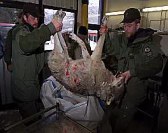 Wolves WolvesWolf History, Conservation, Ecology and Behavior
[www.wolfology.com]
|
The Norwegian Wolf Hunt
Jason Manning
|
In 1973 wolves became a protected species in Norway, with only five to fifteen animals believed to exist in all of Scandinavia by the early 1980s. They were most often seen in the Hedmark area of northeastern Norway, near the border with Sweden. Norwegian wolf researcher Petter Wabakken located and studied three wolves in the forests of Hedmark and neighboring Sweden, and was able to record that a breeding took place in 1983. This Finnskogen Pack was the only breeding pair in Scandinavia during the Eighties. By 1991 there were believed to be two breeding packs, and in 1997 there were supposedly six. In the winter of 2000-2001, Wabakken produced a report indicating that there were at least 10 packs in Scandinavia -- three in Norway and four ranging right along the border of Norway and Sweden -- for a total of 51 to 80 animals.*
In 1997 the Norwegian Parliament approved of a plan that called for the management of viable populations of large carnivores -- the brown bear, the wolverine, the lynx and the wolf. The initial goal for wolves was 8 to 10 packs in all of southern Scandinavia, and a cooperation agreement relevant to wolf management was signed with Sweden. In January 2001, Swedish management goals called for a wolf population of 200. An advisory panel of Norwegian and Swedish experts agreed that a minimum population of 500 wolves was needed to guarantee wolf survival in Scandinavia.
Meanwhile, Norway fashioned a wolf management zone, outside of which wolves would not be allowed, due primarily to a concentration of reindeer and sheep. Unfortunately, the no-wolf zone included the Hedmark area, which is probably the best wolf country in Norway. Wolf advocates complained that the area left for wolves was large enough for only 4-5 packs.
Then, in 2001, Norwegian authorities announced that if winter tracking indicated that there were at least 8-10 family groups of wolves in Scandinavia, wolf hunting would commence. The goal was to exterminate the two northermost packs in the Hedmark area, containing 17 wolves. (This area also contains large numbers of sheep.) The Swedish authorities protested that the hunt, if successful, would eliminate 17-40% of the entire wolf population of Scandinavia. But Norway pressed on with its plans, earmarking $250,000 for the hunt, which would include helicopters and snow scooters.
In February 2001, Norway decided to cull only 9 wolves -- a compromise for which we can thank the Swedes. The first targets were the wolves of the Atndalen Pack and the Imsdalen pair. The local council at Rendalen would be allowed to issue permits for the killing of the Koppang Pack if problems with livestock arose during the upcoming pasture season. On February 8 the Norwegian Carnivore & Raptor Society took legal action in an attempt to postpone the scheduled hunt, its preliminary appeal to the ministry of the environment having been dismissed. The ministry could have postponed the hunt until after the court hearing, but chose not to; the hunt proceeded as scheduled, beginning Saturday, February 9.
On Friday, February 15, the court ruled in favor of the government. Up until that time, the hunters had failed to kill a wolf. But that changed the following Monday, when the first wolf was shot. It was one down, eight to go -- and a giant step backwards for wolf recovery in Scandinavia. (On Sunday, February 25, the Imsdalen pair were killed.)
Update: The government got its quota of nine wolves, and promptly began contemplating another wolf hunt in the autumn. Meanwhile, Swedish authorities reported 10-12 litters of wolf pups born in Sweden in 2001, bringing the number of wolves in that country to about 120. Fortunately, Sweden is totally committed to the full protection of its wolf population.
For more information on the Norwegian wolf hunt, or to voice your opinion, write to
Minister of the Environment Siri Bjerke
Ministry of Environment
Box 8013 Dep.
N-0030 OSLO
Norway
Telephone: +47-22249090
* These included the Atndalen Pack (Norway, 7 wolves), the Koppang Pack (Norway, 10 wolves led by an alpha female (the alpha male was shot in 2000), the Moss-Valer Pack (Norway, 6 wolves), the Bograngen Pack (border, at least 3 wolves), the Nyskoga Pack (border, 3 to 5 wolves), the Arjang-Kongsvinger Pack (border, 5 wolves), the Dals Ed-Halden Pack (border, at least 3 wolves), the Grangarde Pack (Sweden, 6 wolves), the Gravendal-Nittalven Pack (Sweden, 4 wolves), the Pilipstad Pack (Sweden, 5-6 wolves), the Glaskogen Pack (Sweden, numbers unknown), the Hasselfors-Laxa Pack (Sweden, at least 8 wolves). Also reported: the Imsdalen pair (Norway), the Grafjell-Glomma pair (Norway), the Orsa-Furudal pair (Sweden), the Hagfors-Appelbo pair (Sweden) and the solitary Leksand wolf (Sweden).
|
Copyright 2002 Jason Manning All Rights Reserved
Feel free to duplicate for educational purposes.
|
